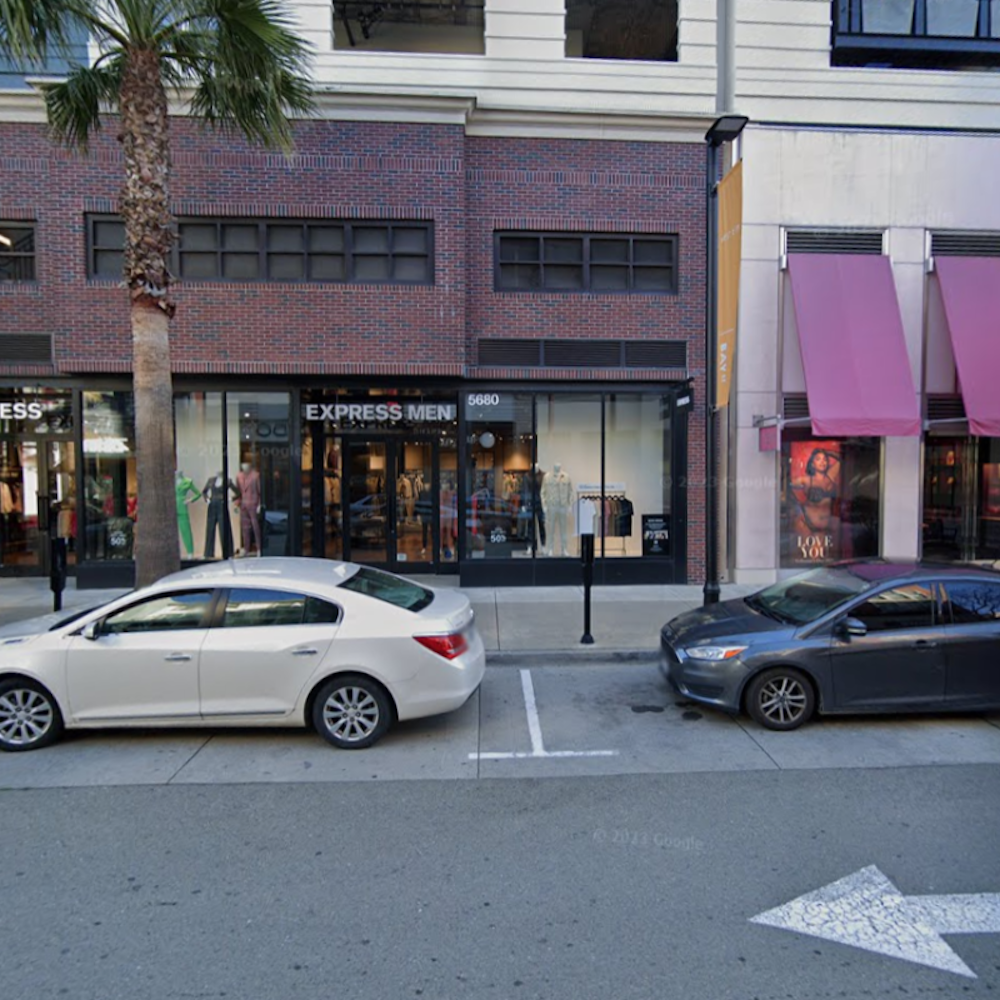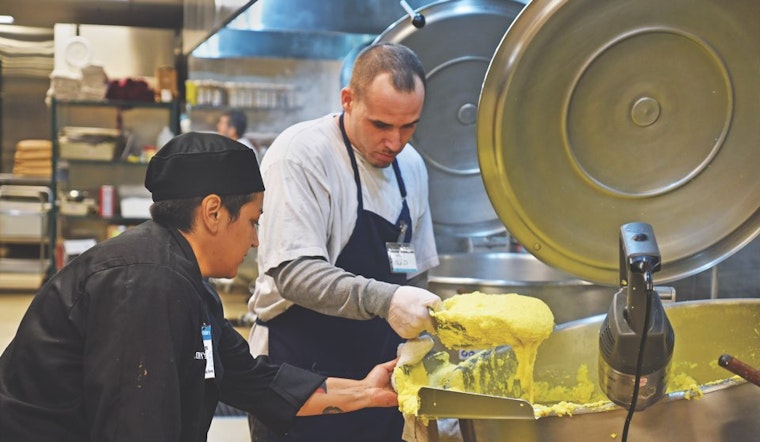
This article, written by Paul Dunn, was originally published in Central City Extra's November 2015 issue (pdf). You can find the newspaper distributed around area cafes, nonprofits, City Hall offices, SROs and other residences—and in the periodicals section on the fifth floor of the Main Library.
Early on the second day of his four-month tenure at St. Anthony’s Dining Room, chef Pepe Sanchez awoke with a smashing idea. He wanted to prepare a nutritious vegetarian dish for St. Anthony’s guests that would be tasty and easy to eat.
But the diners that day ignored Sanchez’s
well-intentioned side dish because, oddly
enough, they had no way to eat it. And that’s
where our story begins ...
On a recent sunny morning in the Tenderloin, Sanchez hovers over a 55-gallon stainless steel steam kettle. It looks like a giant dreidel sans Hebrew lettering. Using a long wooden paddle, he stirs his new concoction — a rose red, delectable-smelling Mediterranean salmon stew.
“I get paid to cook, and I get my exercise at the same time,” he says, the wiry muscles in his shoulders and arms straining against the stew’s current.
The 49-year-old—who sports a dark Mohawk and handlebar mustache—was similarly using his muscles that day as he alternately stirred two steam kettles filled with 50-cent-size carrot “coins.”
To those carrots—“a shit load of ’em,” he says—he added butter and curry powder, then power-blended the mixture into a puree. He figured the dish would be perfect for St. Anthony’s clients and offer some variety after three straight days of blanched carrots with salt.
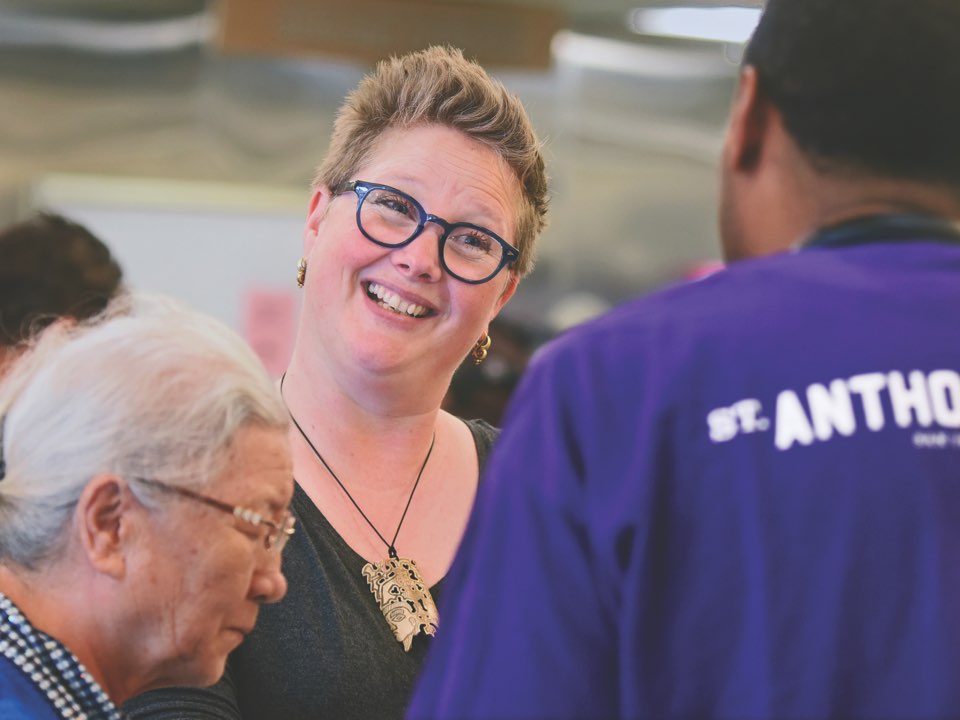 Lydia Bransten, dining room manager, center, chats with a guest, left, and a volunteer at the start of a weekday meal service. “What we are trying to create here is a dignified, respectful place for people to come in and eat in community.” Bransten says. (Photo: Paul Dunn)
Lydia Bransten, dining room manager, center, chats with a guest, left, and a volunteer at the start of a weekday meal service. “What we are trying to create here is a dignified, respectful place for people to come in and eat in community.” Bransten says. (Photo: Paul Dunn)
“I was all happy with myself and wanted to really wow my guests, because a lot of them don’t have teeth,” Sanchez said. “I thought it would be great because it would be easier for them to eat.”
But about halfway through the day’s first food service—reserved for seniors—a volunteer told Sanchez that nobody was eating his prized dish.
They had no spoons.
St. Anthony’s guests receive forks only because the soup kitchen cuisine never requires spoons, eliminating a logistical complication in the complex operation.
“I was embarrassed,” Sanchez now recalls with a grin as he gazes at today’s pot of chunky salmon stew. “It was an epic failure.”
By all accounts, though, Sanchez’s episode, which he laughs about now, has been the exception since St. Anthony’s opened its new dining room a year ago.
The dining room has been on the same Tenderloin corner, Jones Street and Golden Gate Avenue, since 1950. Originally, it was in the basement of an old auto repair shop. That structure, demolished in 2012, was replaced with a new $22.5 million building.
The dining room, open from 10 a.m. to 1 p.m. daily, seats 300 and serves up to 3,000 free meals a day. Guests can have as many helpings as they wish.
The dining room has had operational challenges in its first year—such as how to get food trays from the dining room back to the dishwashing area efficiently—but it’s now on the upswing.
“It was like wearing a new pair of shoes,” said Executive Chef Char Marsden, who has been at St. Anthony’s on and off for more than 13 years. Marsden, 53, an Aussie who has been cooking since age 18, said, “We got a few blisters, but now we’re starting to hit our stride.”
Blisters, indeed.
The sheer size of the place—nearly half again the size of the old dining room—can cause feet to ache, especially for the 45 to 60 volunteers who hustle back and forth delivering and returning food trays.
“There’s a lot of walking, and [the volunteers] are up there in age,” Marsden said.
“You realize how big it is when you’re carrying a tray and go back there 40 times a day. You could walk six miles in a day doing that.”
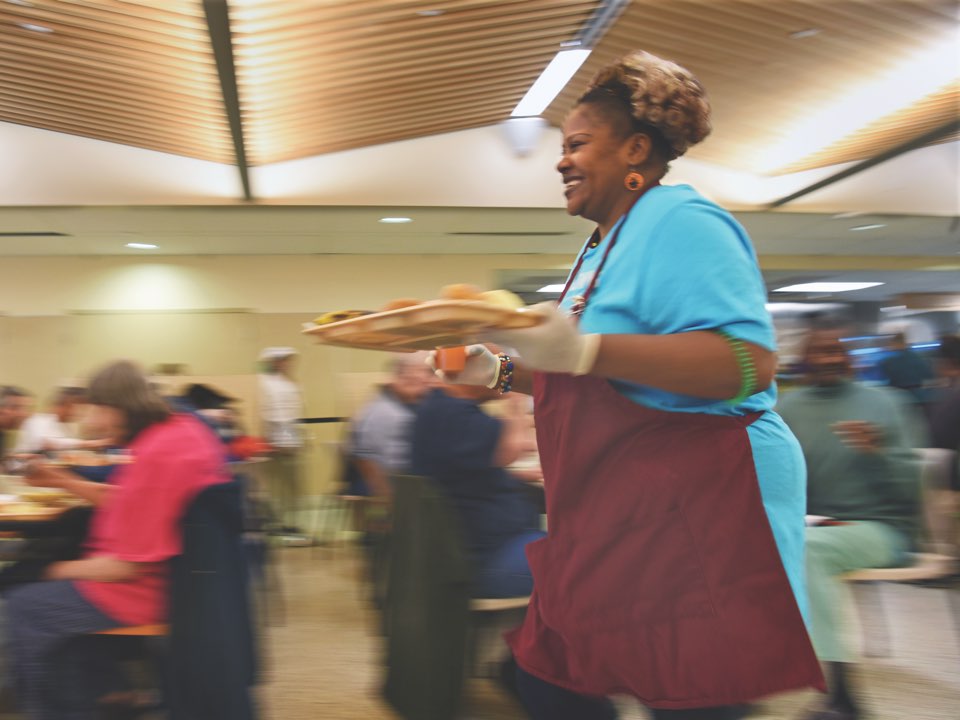 Volunteer Patricia Davis hits her stride while serving during the height of meal service. (Photo: Paul Dunn)
Volunteer Patricia Davis hits her stride while serving during the height of meal service. (Photo: Paul Dunn)
St. Anthony’s diners, though, probably haven’t noticed. For them, the spacious new dining room is a godsend.
“They could not believe that this place was built for them,” Marsden said. “Their reaction has been overwhelming gratitude.”
Dining room manager Lydia Bransten, 49, who began her St. Anthony’s career in 2006, says, “What we’re trying to create here is a dignified, respectful place for people to come in and eat in community. Having that reflected in the space in which they’re eating is really important. And because the dining room is not as tight, folks are more comfortable, and when you’re more comfortable you’re more pleasant.”
The new dining room was needed to accommodate the “changing face of hunger in the Tenderloin,” says St. Anthony’s communications associate Jessie Brierley. “With a population that’s growing and changing, it was important that St. Anthony’s have a flexible space.”
That changing face of hunger over the years has prompted St. Anthony’s to change its menus to accommodate the fluctuating population. Meals now are typically healthier and more varied.
Diners are offered a well-balanced selection of meals that consist of an entree, starch, vegetable, fruit and dessert with fruit juice, Tang or water to drink. Entrees rotate daily and typically include roast chicken, baked salmon, pizza and chili, with specials like pasta puttanesca, ginger lentils and chickpea curry.
Once in a blue moon there’s a beef dish, such as about five months ago when chefs made 3,000 hamburgers on the kitchen’s two 6-foot-long grills.
“We had the whole Tenderloin smelling like a Burger King,” Marsden said, noting that the old dining room chefs were unable to grill food. That hamburger experiment was wildly successful, but hasn’t been repeated. Too expensive. A typical meal with beef costs $2,500, Marsden said.
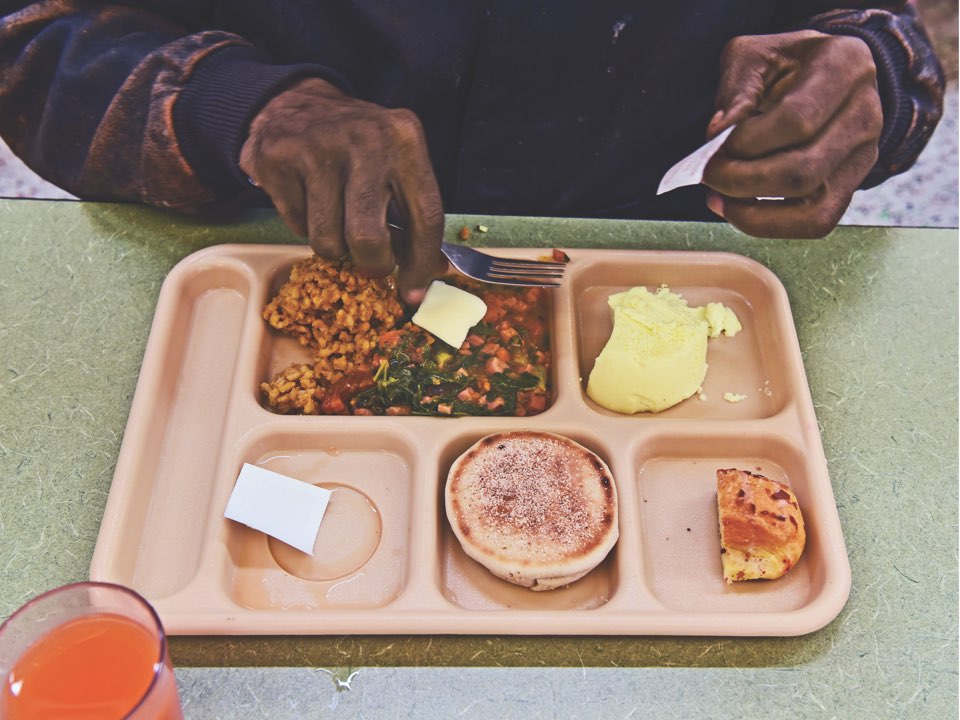 A guest digs into a satisfying meal that includes ham and collard greens over barley, and an assortment of healthy side dishes such as polenta and an English muffin. (Photo: Paul Dunn)
A guest digs into a satisfying meal that includes ham and collard greens over barley, and an assortment of healthy side dishes such as polenta and an English muffin. (Photo: Paul Dunn)
The executive chef, who spent her career in the restaurant business before joining St. Anthony’s, plans menus a month at a time. She normally has about 60 combinations of meals to choose from and bases her decisions on food she knows she’ll always have, such as turkey, chicken and hot dogs—then augments the meals if special items magically come her way.
“My reservation book (for guests) is always full here,” Marsden said, grinning. And through it all she tries to focus on their health, offering food that is both tasty and nutritious.
“We are using much more fresh and even frozen food and vegetables than we used to,” she said.
And the dining room’s guests flock
to the healthy stuff. Right?
Umm, not so much.
Many live on hamburgers and French fries when they have money to spend, so that compels Marsden to periodically “pull fast ones on them.” That means mixing vegetables and meat or meat and beans so they have to eat the healthy with the tasty.
“They usually say, ‘This is good, you know, because it has a hunk of meat in it.’”
Adds Sanchez: “Our clients are a fragile population. They don’t have the same immune systems as your average person has, so we try to make sure that the ingredients we use are fresh and that we’re putting out a safe meal every day.”
The dining room serves 2 million pounds—1,000 tons—of food a year. Onsite and off it stores 4 tons of food, and also keeps on hand a three-day supply of canned earthquake emergency food, some of which it adds to meals once a year, then replenishes.
The dining room obtains most of its food from three sources: individual and corporate donors, the S.F.-Marin Food Bank and BiRite Foodservice Distributors. Up to a quarter is donated.
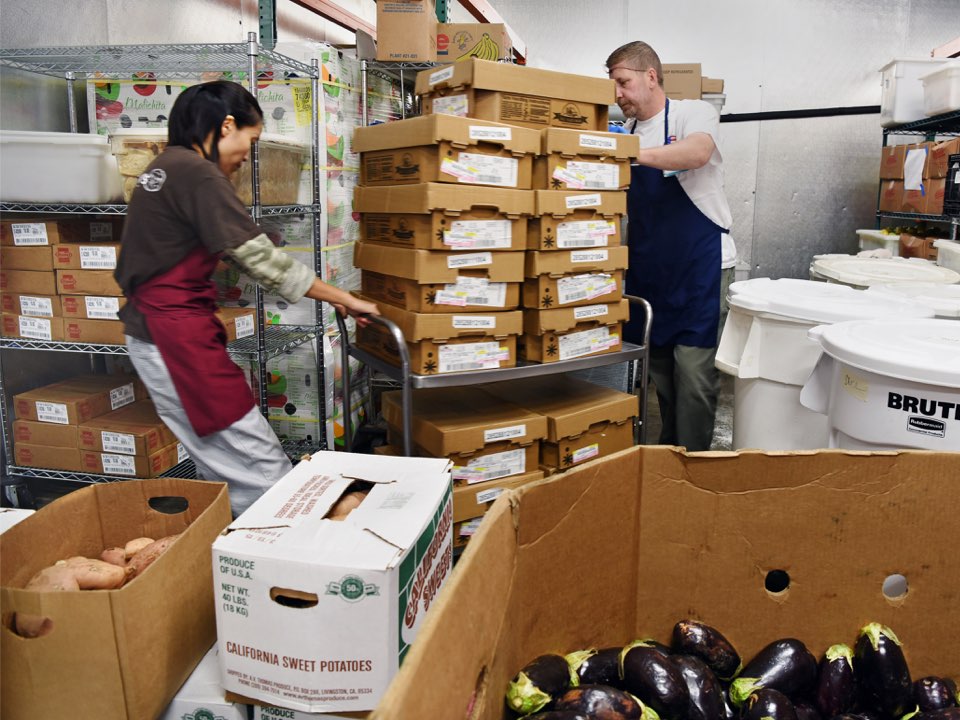 Chef Teresa Huang, left, and volunteer Rob Holstead move food into the prep area where three chefs work. (Photo: Paul Dunn)
Chef Teresa Huang, left, and volunteer Rob Holstead move food into the prep area where three chefs work. (Photo: Paul Dunn)
Four tons sounds like a lot of food, but St. Anthony’s six chefs—three in the prep area downstairs who organize the food, and three upstairs who prepare it—are careful to avoid waste. “We try to balance out our quantities,” Sanchez said. “It’s a fine line. You don’t want to run out, but you also don’t want to have too much leftovers.”
Leftover food is quickly placed in the kitchen’s rapid-cooling “blast chiller” to be stored for future meals. “What was cooked today may not be able to be used tomorrow, but we can store it and the next time we serve that meal we can add it to it,” Sanchez explained. The kitchen crew begins preparing each day’s meal at 6:30 a.m. to be able to start serving at 10. By 2:30 p.m. the kitchen’s clean, ready for the next day.
Staff clean as they go.
“You are never resting; there is always something to do,” Sanchez said.
Part of that may be due to all the new-fangled appliances he and his colleagues have at their disposal — which must be painstakingly cared for. They include six new 55-gallon steam kettles that can each cook 100 pounds of food at once, two 6-footlong grills, three Baxter ovens that can cook 13 sheet pans of food simultaneously, and a combination steam/ convection oven.
“We just have more equipment now and are able to produce more food more efficiently,” Marsden explained. “It’s probably not any faster than it used to be, but it makes it tastier and we can accomplish more.”
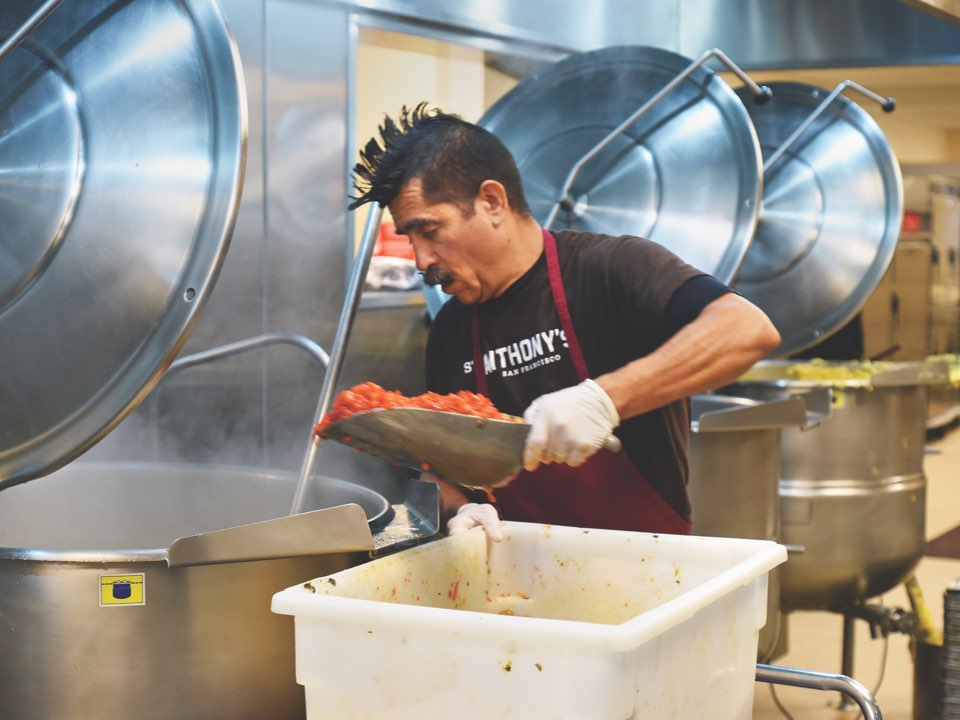 St. Anthony’s Dining Room chef Pepe Sanchez adds ingredients to his Mediterranean salmon
stew in one of the kitchen’s six huge steam kettles. St. Anthony’s feeds up to 3,000 people daily. (Photo: Paul Dunn)
St. Anthony’s Dining Room chef Pepe Sanchez adds ingredients to his Mediterranean salmon
stew in one of the kitchen’s six huge steam kettles. St. Anthony’s feeds up to 3,000 people daily. (Photo: Paul Dunn)
By most reasonable predictions, St. Anthony’s Dining Room will continue to accomplish more in the years ahead just to keep up with demand — for Marsden a lamentable prospect.
“I wish I didn’t have this job,” she said, not because she doesn’t like it, but because the number of down-and-out guests is growing.
In a city famous for its wealth and prosperity, the jarring sight of people lined up around the block for free meals is disconcerting.
“What I see on the street is that our clientele is increasing,” she said. “And the crowd now is younger and younger, and there are women and families. It’s heartbreaking.”
For those in need of a hot Thanksgiving dinner, St. Anthony's chefs and 180 volunteers will be serving turkey, yams and all the fixings from 10am to 1:30pm today.

